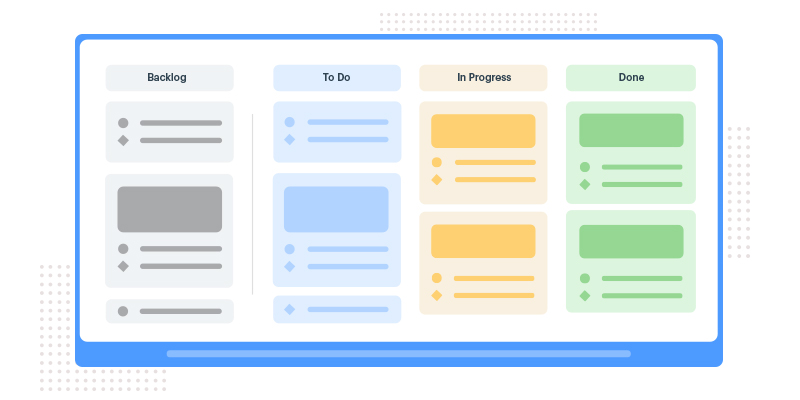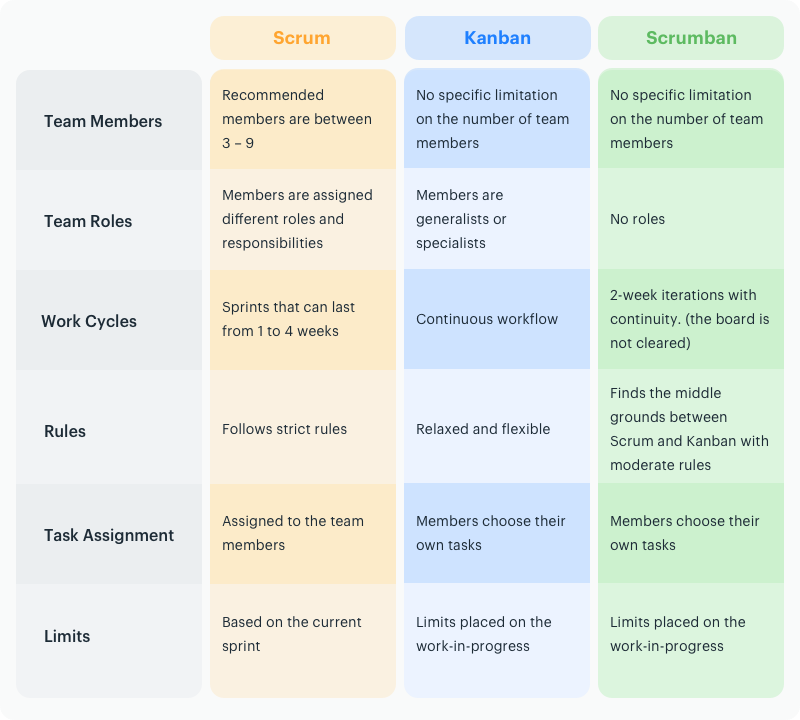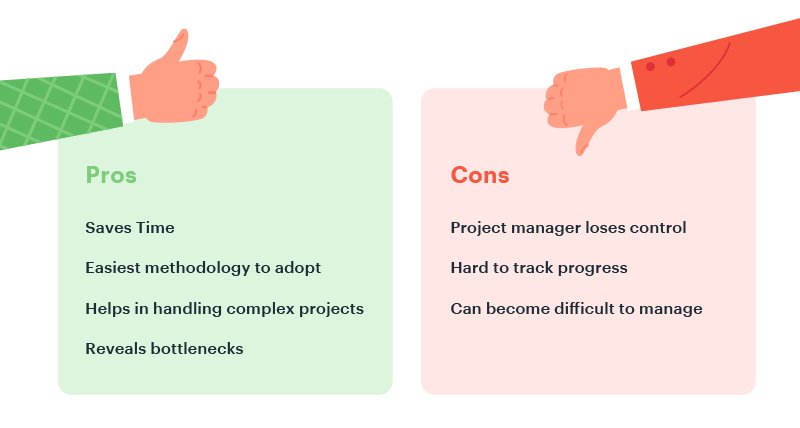If you have ever been associated with project management, chances are that you have heard of methodologies like Scrum and Kanban. Scrum comes under the agile umbrella while Kanban has its roots in the Lean philosophy. These are considered two of the most used approaches in the project management world.
There is another popular methodology that combines both Scrum and Kanban–Scrumban.
Scrumban is a hybrid methodology that combines all the benefits of Scrum and Kanban. It is a great fit for fast-paced and continuous projects that feel challenged by the limitations of Scrum and Kanban. Moreover, the methodology is flexible enough to be used for both short-term and long-term projects.
In this article, you’ll understand what Scrumban is and why it’s becoming so popular in the industry.
Scrum and Kanban
Before we go into the what, why, and how of Scrumban, let’s take a moment and briefly see what the Scrum and Kanban methodologies are.
Scrum, in a nutshell, is a simple and iterative Agile methodology that divides a project into smaller, manageable tasks. Scrum introduces the concept of sprints, that are pre-defined periods, in which the team focuses solely on the goal at hand. You are free to choose any sprint length as long as it is between 1 to 4 weeks. However, 2 weeks sprints are a common standard.
Scrum operates on the concept of retrospection while Kanban delivers visualization and workflow continuity. It’s also well-known for its simplicity and compatibility. Unlike Scrum, which revamps the existing setup, Kanban focuses on increasing its efficiency.
A Kanban setup has a Kanban board with at least three basic columns that can tell you the progress of your project at a glance.
From the above picture, you can see that a specific task, represented by a card, moves from the leftmost column to the rightmost one. This is the most basic version of a Kanban board and you can add more columns according to your need.
Contrary to Scrum, where the limiting factor is time (sprints), Kanban limits the work-in-progress to ensure that the team is not overwhelmed by having too much to do at once.
What is Scrumban and why do we need it
Scrum + Kanban = Scrumban
Scrum and Kanban come with their own set of pros and cons. This makes them a suitable option for specific types of projects only. Modern projects, however, are more complex and come with multidisciplinary requirements. Scrumban combines the concepts of Scrum and Kanban and delivers results with continuity.

The concept of Scrumban was developed for teams to transition to Kanban from Scrum. Over time, it became popular on its own because of how it combines the positive elements of both Scrum and Kanban to deliver the best results.
Tired of using Asana?
How does Scrumban work?
Just like Scrum, Scrumban works in small iterations of 2 weeks and visualizes the entire project on a Scrumban board, which is similar to a Kanban board but gives you more information and freedom. From the Kanban system, this methodology takes the concepts of pulling work, limiting WIP, and continuous operations.
The following are some of the major concepts in Scrumban:
1. Iterations
Scrumban methodology recommends working in two-week long iterations. The goal is to deliver working results after the completion of the cycle. In hindsight, these iterations look similar to regular sprints in the Scrum methodology, but there are some major differences.
- Scrumban iterations are relatively shorter. two weeks is the maximum limit of a Scrumban iteration.
- In Scrumban, the tasks are not assigned to the team members. They rather choose the task themselves.
- To prevent overburdening the team, a WIP limit is set in the to-do column.
2. On-demand planning
Scrumban builds on Kanban’s flexibility in the planning process by introducing the concept of need-based or on-demand planning. These planning sessions are integrated with the condition of the work-in-progress column.
Whenever the number of current tasks falls below a threshold level, a planning trigger is initiated which lets the team know that it’s time to start the planning process.
In Scrumban, there is no recommended value for the planning trigger, as it purely depends on the speed of your team and the complexity of the project. During the on-demand planning process, teams only pick the tasks from the three-month bucket to maintain the predefined priorities.
And don’t forget to try our Free and Customizable Templates:
– Content Calendar Template for Strategic Content Planning
– Competitive Analysis Template for Strategic Content Planning
3. Bucket planning
Scrumban introduces the idea of bucket planning that allows teams to plan for longer terms. The concept requires an idea to go through three buckets before making its way to the Scrumban board.
The three buckets are:
a) One-year bucket
Used for the company’s long-term goals that require more time and effort or have some sorts of pre-requisites. In a one-year bucket, you’ll only find vague ideas without any details on their requirements or how they’ll be manifested.
b) Six-month bucket
This bucket is dedicated to plans that have been approved by the management. The ideas from the one-year bucket are now turned into achievable plans with specific requirements and goals.
c) Three-month bucket
The final stage where plans from the six-month bucket are further divided into achievable tasks.
4. Lack of roles
Scrum requires specific roles within a team while Kanban differentiates between project management specialists and generalists. Scrumban, however, removes all the roles completely and gives equal roles to every member.
In Scrumban, the team members are free to prioritize tasks from the board as well. This reduces the pressure on the team members and allows them to work on their terms which can boost their performance.
Tired of using Wrike?
5. WIP limits
Researchers at Stanford claim that multitasking not only negatively affects your performance, it also has the potential to damage your brain. In Scrumban, you minimize multitasking with WIP limits.
Putting a cap on the work-in-progress helps you focus on a single task and maintain your productivity. You’ll also be able to handle potential bottlenecks, be more efficient, and deliver more value. All you have to do is to prevent your team members from being overwhelmed with too many tasks at once.
6. Task prioritization
Team members select their tasks but you can inform them about the ones that need to be completed first. In the Scrumban methodology, managers indicate a priority order by numbering tasks or any other method to ensure that teams know what needs to be done sooner.
Scrum vs Kanban vs Scrumban

Here is our Customizable Marketing Templates to try for Free:
– Marketing Plan Template to Streamline your Marketing Efforts
The advantages and disadvantages of Scrumban
Scrumban is getting popular by the day because it cancels out the limitations of both Scrum and Kanban while enhancing their positive elements. The methodology is perfect for event-driven projects and other areas where a certain level of workflow continuity is essential.
Following are some of the major advantages of the Scrumban methodology:
1. Scrumban saves time and is more effective
Scrumban aims to introduce efficiency in the processes and only requires you to hold planning sessions when needed. Additionally, members don’t have to spend too much time reporting and preparing for the daily standup which allows them to focus on the tasks at hand.
2. Scrumban is perfect for large-scale projects
Scrumban is a perfect choice for complex and time-consuming projects as it comes with the inherent capabilities of facilitating long-term plans.
3. Scrumban is very easy to adopt
Deriving from Kanban, which is extremely flexible and can fit in any existing setup, Scrumban is very easy to adopt.
4. Scrumban teams are more relaxed and perform better
Team members are free from the confines of roles and can select their tasks without much involvement from the manager. Additionally, they don’t have to worry about daily standups and other reports which creates a relaxing work environment.

Now, let’s take a look at some of the drawbacks of using the Scrumban methodology:
1. Scrumban can become too hard to handle
Compared to other methodologies, Scrumban is new and untested. There is also a lack of established best practices so teams usually incorporate concepts on their own which can become confusing.
2. Scrumban does not have an effective setup for tracking progress
There is no established setup for assigning tasks and no progress tracking system which can make planning harder.
3. Project managers do not have much control over Scrumban teams
If you are one of those managers who prefer a hands-on approach and like to stay on top of things, Scrumban will give you a hard time. The methodology is designed to limit the control of managers and grant more autonomy to the project team management.
What’s next?
Scrumban provides the structure of Scrum and the flexibility of Kanban, making it a versatile approach for most teams. However, like all other methodologies, it comes with its own advantages and disadvantages. Before deciding on the methodology, you need to be aware of the limitations of the methodology and the needs of your team.
Worried about how to manage your growing list of projects?
We have built a FREE solution. Just for you.
